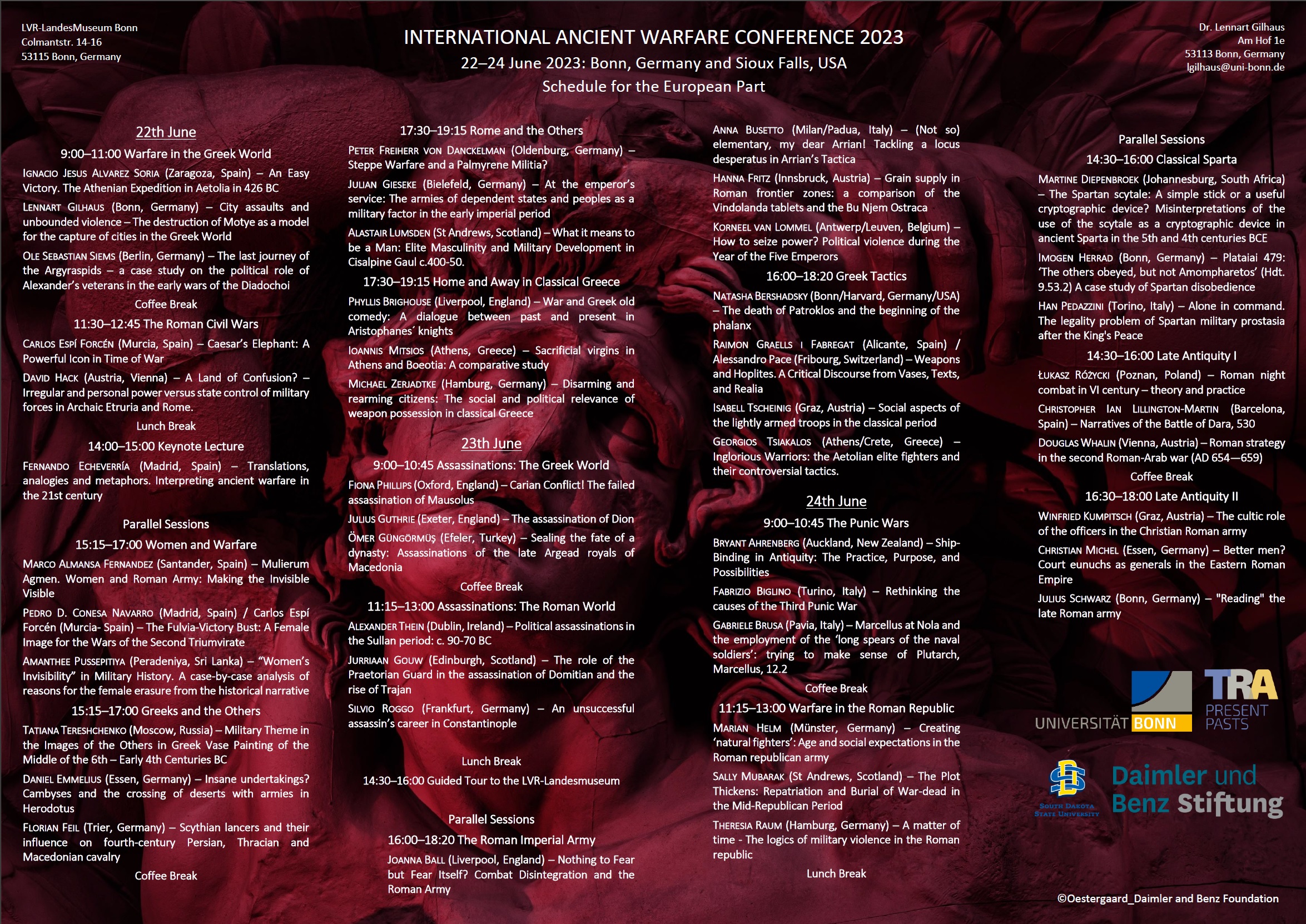Douglas Whalin late antique historian
Paper from the IAWC 2023
I attended the International Ancient Warfare Conference (IAWC) on 22-24 June 2023 in Bonn, Germany, delivering a paper titled ‘Roman strategy in the second Roman-Arab war (AD 654—659)’. A parallel conference was held in Sioux Falls, South Dakota, for the benefit of researchers based in the US and Canada. The conference used to run quite regularly up until 2020. My thanks and compliments to the organizers who worked hard to resuscitate the event, which I understand had not occurred regularly in the previous few years due to the pandemic. The structure of the Bonn conference mixed in-person and online attendance. Probably two-thirds of the papers were delivered live in-person, whilst the remaining third were prerecorded videos with the presenter then fielding questions via Zoom. There were occasional technical issues, but I generally came away that the trouble was well worth it for the increased accessibility.

It was a great chance to meet new colleagues, listen to some very stimulating papers, and to explore the city of Bonn a bit.
Although hosted by the University of Bonn, the venue was provided by the LVR-LandesMuseum Bonn. The conference organizers kindly arranged a guided tour of the museum’s current exhibit Das Leben des BODI. Eine Forschungsreise ins frühe Mittelalter. The exhibit featured grave goods from a Frankish burial ground dating to circa AD 600 near Bislich on the Lower Rhine. I can imagine that curating such materials in an interesting and engaging way can be difficult, and I though the museum found a novel and suitable approach. In order to create a narrative out of these objects, the exhibit focused on a single grave – which contained a gold ring with the name BODI clearly visible – as an axis around which to explore and describe material conditions in this time and place. Goods from the Bislich cemetery were supplemented with other objects from the fifth-sixth centuries as well as reproductions of some fragmentary objects. This was a temporary exhibit running from 23 March to 15 October 2023.
Back to the conference though, this is the abstract of my paper, followed by a link to the YouTube video of my paper and Q&A session. My thanks to both of my current host instituions, IHAC and the ÖAW, for thier support.
= = =
Roman strategy in the second Roman-Arab war (AD 654—659)
After fifteen years of war, the initial Muslim conquest of once-Roman western Asia paused with a truce negotiated in 650 between the governments of Caliph Uthman (644—656) and Emperor Constans II (641—668). Both sides faced pressing priorities in other theatres and used the time to prepare for the inevitable resumption of hostilities. After consolidating gains on the Iranian plateau, Uthman used the truce to organise a massive expedition. His intent seems to have been to rapidly capture Constantinople in a single campaign season thereby swiftly decapitating the administrative heart of the eastern Roman Empire. Constans, facing mutinies and attempted usurpations from multiple quarters, needed time to shore up his domestic political position.
Historical accounts regarding the second Roman-Arab war, which lasted from 654 to 659, are fragmentary and contradictory. It is clear that the Arab armies landed one or more major blows – including a probably-apocryphal story about looting the remnants of the Colossus of Rhodes to sell as scrap metal. It is also clear that the result was that the Romans blunted or parried each of them, with the empire not only surviving but the war ending on favourable terms for them. Yet no Roman or Arab historian left behind a definitive narrative about the war, and the fragmentary sources which do survive are distanced from the events they describe by time, space, language, or all three. Analysing surviving accounts carefully and critically, this paper will propose a reconstruction of the contours of this conflict. In so doing, it will offer preliminary answers to larger questions about what contributed to the general success of Roman military strategy under Constans II and his son Constantine IV (668—685).
= = =
July 13th, 2023 by DC Whalin